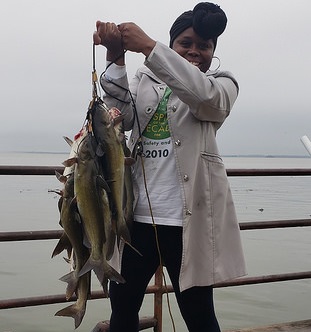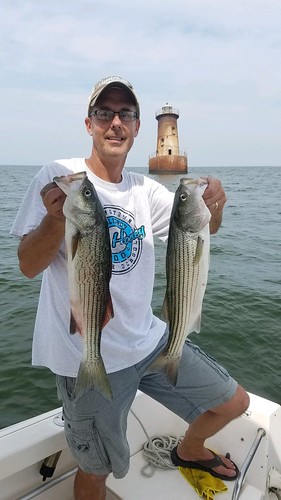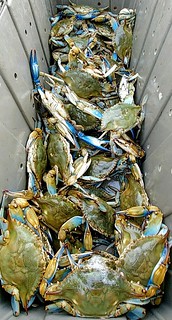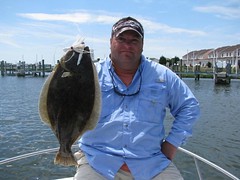Maryland Fishing Report: September 19

La’Tanya Demory recently had a favorable day of fishing at Perry Point on the lower Susquehanna River. Photo courtesy of La’Tanya Demory
For those who work hard, a day off is a precious opportunity to spend time the way we want. Few activities afford us the peace to be had dangling a line in the water and being with our thoughts. Sometimes fate smiles on us and we actually have one of those days where everything works in our favor.
Some upcoming events offer some opportunities for anglers of all ages.
National Hunting and Fishing Day will be celebrated from 10 a.m. to 4 p.m. Sept. 22 at the Washington County Izaak Walton League in Clear Spring. Maryland Department of Natural Resources staff will be there to run a casting clinic and answer questions about fishing around the state, along with shooting sports demos and hunter safety clinics.
The Second Annual Rod and Reef Slam Tournament will be held Sept. 22 at various artificial and restored oyster reef sites along the Eastern Shore. This is a catch, release and photo tournament.
Note to anglers: The Talbot County section of Bill Burton Fishing Pier State Park will be closed to the public until further notice while the staff installs new lighting fixtures. The trails and parking lot will remain open.
Forecast Summary: Sept. 19-25
As we leave the remnants of Hurricane Florence in our rearview mirror and the first day of fall comes this weekend, the fishing pattern will be similar to last week. The cool, rainy and windy weather has kept water temperatures cool and well mixed, providing favorable conditions for rockfish. Anglers should continue to seek the best combination of clear, cool and oxygenated waters, which will be evenly mixed from the surface down into deeper waters.
At the National Oceanic and Atmospheric Administration buoys, water temperatures are cool and should remain stable all week, with Annapolis and Gooses Reef both at 78 degrees, and Point Lookout at 79 degrees. Expect poor water clarity from the high flows coming from most rivers and streams. The Susquehanna River’s muddy water will likely extend below Swan Point with poor water clarity also found at Annapolis and Gooses Reef. There will be above average tidal currents Thursday through Tuesday as a result of the full moon Sept. 26.
For the full weekly fishing conditions summary in your area, please be sure to check out Click Before You Cast.
Despite some breezy conditions over the weekend, sunny skies prevailed and a few fishermen found places to tuck in and fish. The lower Susquehanna River is running hard as flows from the Conowingo Dam are brisk, and may increase if the upper Susquehanna watershed gets a lot of rain. Despite these conditions, there is some decent action for striped bass by casting topwater lures, crankbaits and swimbaits.
Waters remain stained and chumming, chunking or live lining spot are the most productive ways to dial in on striped bass suspended along channel edges. Swan, Love and Podickory points continue to be go-to locations as are the Francis Scott Key Bridge and Bay Bridge. Bluefish are showing up in chum slicks and also are cutting up spot baits.
There is some exciting breaking fish action as a mix of bluefish and small striped bass chase schools of bay anchovies. The mouth of the Chester River and Magothy River have been two places where a lot of this action is taking place. Jigging underneath the surface action can often produce larger striped bass.
The Bay Bridge is providing plenty of striped bass action with some bluefish thrown in for good measure. The rockfish have been suspended at about 20 feet but are being lured to the surface at times when bait is being swept along in the swift currents. Jigging, casting topwater lures chunking and live lining spot have all been good ways to fish.
Spot can still be found in the shallower parts of the tidal rivers and the west side of the Bay Bridge in about 15 feet of water on hard bottom. White perch are also in the mix as are channel catfish. Cooler water temperatures have also lured white perch back to shallower shoreline structure areas as well as striped bass in the mornings and evenings.
Cooler weather, wind and rain have done much to get the ball rolling in regards to the bay transitioning from oppressive summer to cooling fall temperatures. Currently water temperatures have dropped to the mid-70s and the bay waters are doing a rollover, bringing oxygenated water to the cooler depths that fish prefer. The surface salinity readings are also low, reading 4.3 parts per thousand at Gooses Reef.
Diving seagulls have been marking the way to breaking fish, a mix of bluefish, striped bass and Spanish mackerel, following schools of bay anchovies near the mouths of the tidal rivers and the steeper channel edges in the bay. Often the striped bass on top tend to be small, but jigging below the surface mayhem can find you larger fish. Downsizing to lighter spin tackle or pulling out a 5 or 7 weight fly rod with a sinking tip and your favorite fly or a floating line with a skipping bug can offer some fun catch-and-release fishing on the smaller striped bass.
Live lining spot for striped bass along channel edges has been a very popular way to catch the larger striped bass that tend to be suspended at about 20 feet along traditional channel edges. Spot are still readily available on hard bottom in the region’s tidal rivers in about 15 feet of water. Thomas Point, the outside edge of Hacketts, the Brick House Bar off Kent Island and the False Channel are a few of the more popular edges to live line.
The shallow water fishery for striped bass has improved with cooler water temperatures along shoreline structure. This type of fishing is still an early morning or late evening affair and although topwater lures can offer the most fun in shallow areas, swimbaits and crankbaits can be just the ticket near piers and jetties where the water may be deeper. White perch can also be found in these same areas now that waters have cooled down a bit and caught on small jigs and spinnerbaits.
Good fishing for a variety of species continues this week but subtle changes are beginning to take place as water temperatures begin to cool and oxygenated water returns to deeper waters. The catch-and-release fishery for large red drum shows signs of winding down. They can still be found on hard bottom lumps in about 25 feet of water and jigging with large soft plastics or metal tends to be the most popular way to fish for them. Trolling with large spoons on planers is another good option.
Spanish mackerel are spread throughout the area with some of the hottest action taking place in the Tangier Sound area. The Spanish mackerel have been mixing it up with bluefish and crashing into schools of bay anchovies. Trolling small spoons and hoses behind planers has been one of the best ways to fish for them. Casting into the surface action is always exciting and using small jigs or spoons is a fun way to fish for them with light tackle.
Live lining spot for striped bass continues to be a great way to catch fish this week along steep channel edges in the lower Potomac, Patuxent and out in the bay. The striped bass tend to be suspended at about 25 feet along the edges at St. Georges Island down to Piney Point. The lower Patuxent is holding striped bass near the Route 4 Bridge piers and Cedar Point. The channel edge at Cove Point is another good place to check for suspended fish. Chumming for a mix of bluefish and striped bass can offer a lot of action in the lower Potomac and Point No Point.
Bottom fishing for a wide variety of species offers some fun fishing throughout the region. The lower Potomac and Patuxent rivers have been providing great fishing for large spot with a mix of croaker, small sea trout, flounder, white perch and bluefish. The mix is much the same in the Tangier and Pocomoke sounds but with greater numbers of large spot and croaker. Fishing for flounder is also an option worth exploring in the Tangier and Pocomoke sounds. Hard bottom areas along channel edges are a great place to drift with flounder enticing baits.
Recreational crabbing is about as good as it gets in all three regions of Chesapeake Bay. The best crabbing tends to be in the middle and lower bay regions in relatively shallow water. Cooler water temperatures have the crabs roaming the flats and stocking up reserves for the long winter. Razor clams remain the most popular bait but fresh chicken necks are catching their share. Scraps such as fish heads from white perch and bluefish can also work wonders when used in collapsible crab traps.
Many of the streams and creeks in the western region have settled down in regards to reasonable flows including the North Branch Potomac River and the Savage River. Farther down, the upper Potomac near Paw Paw is still experiencing flood conditions much too high to be out on the water.
The fall trout stocking program recently began with the stocking in the North Branch Potomac River. The Barnum, Westernport and catch-and-release areas were stocked with 500 rainbow trout each. The trout stockings will be posted on the trout stocking website as they occur or sent out through the email subscription service.
Alan Klotz sent in this great report about fly-fishing during overcast days, “During drizzly overcast days in the fall, great hatches of small #20 olive-bodied mayflies can occur. Unlike the explosive strikes produced by the grasshopper patterns, trout will sip these small mayflies constantly in their feeding position. You will need light tippet 6x or 7x, and cast with precision. Try using a parachute pattern with a bright white wing to help see this fly on the water. The Youghiogheny River Catch-and-Return Trout Fishing Area has great hatches of these mayflies, and this hatch gives anglers reason to look forward to those drizzly fall days!”
Cooler weather in the western region has done much to lower water temperatures in Deep Creek Lake. Smallmouth bass and largemouth bass can be found more active in a variety of locations. The largemouth bass can be found holding near shoreline structure areas, grass and floating docks. Casting swimbaits, soft plastics, stick worms, small crankbaits near these areas can offer some good fishing. Smallmouth bass can be found near rocky points, submerged wood, floating docks and deep grass. Tubes tend to be one of the more popular baits.
Soon shallow grass will begin to diminish and will signal the fall migration of baitfish and crayfish to deeper structure. You can bet smallmouth bass and largemouth bass will be waiting in transition areas to intercept them. Crayfish looking crankbaits and jigs will be excellent baits to use at this time.
Yellow perch and crappie are becoming more active and soon walleye will be coming up from the depths of Deep Creek Lake to feed along steep rocky shores. Yellow perch and bluegill sunfish are offering plenty of fun fishing at the lake and nearby reservoirs.
Largemouth bass are beginning to feel the urges to feed more actively as water temperatures cool. Grass beds are beginning to diminish due to shorter daylight so existing grass is a great place to target. Largemouth bass will also be lingering longer in the shallower areas and holding in transition areas rather than heading to deeper waters. In tidal waters try to fish the outside of grass or spatterdock edges on an ebbing tide with spinnerbaits and jerkbaits. Deeper sunken wood, bridge piers and rocks can be fished with grubs, jigs and drop shot rigged stick worms.
Cooler water temperatures have channel and blue catfish very active in the many tidal rivers that they can be found. The Potomac, Patuxent and Nanticoke rivers have expanding populations of blue catfish and a bountiful resource for those wishing to stock up their freezers with a light mild flavored fish. Channel catfish inhabit all of the tidal rivers that feed into the bay and are present in a few selected reservoirs such as Piney Run.
Sea conditions in the Ocean City region have calmed down and fishing from the shores and offshore areas have resumed in earnest. There is still some wind chop along the beaches with some moderate wave action. Kingfish are once again biting and the cooler water temperatures and overcast skies have the action lasting beyond early morning activity.
At the inlet, sheepshead are being caught along the jetties on sand fleas and pieces of green crab along with a few triggerfish. Flounder are also are being caught in the inlet and Route 50 Bridge area. Two of the most productive ways to fish is to work Gulp Mullet baits along the bottom or drifting live mullet, small menhaden or spot close to the bottom for the largest flounder. At night there are also some striped bass being caught by working swimbaits or drifting live baits.
Flounder fishing in the back bay channels started right up again after last week’s windy conditions and water clarity improved. The East Channel and the Thorofare have been two of the more popular channels to fish.
The fleet started to head out to the wreck and reef sites Monday and found sea bass, flounder and bluefish. As water temperatures begin to cool the sea bass fishery will start to come back to life and in a month or so tautog should start to show up on the shallower wrecks.
Poorman’s Canyon came alive this week as calmer seas allowed boats to sample what might be there. They found blue and white marlin and many releases were reported. Small dolphin seemed to be everywhere and many boats limited out. Hopefully the yellowfin tuna that are holding north of us will start to pass through our waters soon.
“There is nothing that attracts human nature more powerfully than the sport of tempting the unknown with a fishing line.” – Henry Van Dyke, 1899
Keith Lockwood has been writing the Fishing Report since 2003 and has had a long career as a fisheries research biologist since 1973. Over the course of his career he has studied estuarine fishery populations, ocean species, and over a decade long study of bioaccumulation of chemicals in aquatic species in New Jersey. Upon moving to Oxford on the eastern shore of Maryland; research endeavors focused on a variety of catch-and-release studies as well as other fisheries related research at the Cooperative Oxford Laboratory. Education and outreach to the fishing public has always been an important component to the mission of these studies. Keith is an avid outdoorsman enjoying hunting, fishing, bird dogs, family and life on the eastern shore of Maryland.





